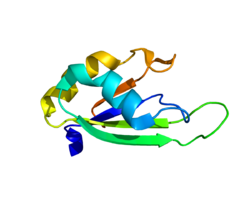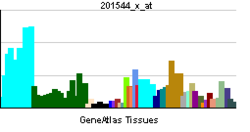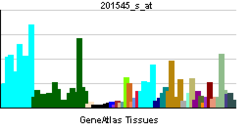- PABPN1
-
Polyadenylate-binding protein 2 (PABP-2) also known as polyadenylate-binding nuclear protein 1 (PABPN1) is a protein that in humans is encoded by the PABPN1 gene.[1][2]
Contents
Function
This gene encodes an abundant nuclear protein that binds with high affinity to nascent poly(A) tails. The protein is required for progressive and efficient polymerization of poly(A) tails on the 3' ends of eukaryotic genes and controls the size of the poly(A) tail to about 250 nt. At steady-state, this protein is localized in the nucleus whereas a different poly(A) binding protein is localized in the cytoplasm. An expansion of the trinucleotide (GCN) repeat from normal 10 to 11-17 at the 5' end of the coding region of this gene leads to autosomal dominant oculopharyngeal muscular dystrophy (OPMD) disease. [3] Multiple splice variants have been described but their full-length nature is not known. One splice variant includes introns 1 and 6 but no protein is formed.[2]
Interactions
PABPN1 has been shown to interact with SNW1.[4]
References
- ^ Brais B, Xie YG, Sanson M, Morgan K, Weissenbach J, Korczyn AD, Blumen SC, Fardeau M et al. (Aug 1995). "The oculopharyngeal muscular dystrophy locus maps to the region of the cardiac alpha and beta myosin heavy chain genes on chromosome 14q11.2-q13". Hum Mol Genet 4 (3): 429–34. doi:10.1093/hmg/4.3.429. PMID 7795598.
- ^ a b "Entrez Gene: PABPN1 poly(A) binding protein, nuclear 1". http://www.ncbi.nlm.nih.gov/sites/entrez?Db=gene&Cmd=ShowDetailView&TermToSearch=8106.
- ^ Brais, B (2009 Jan). "Oculopharyngeal muscular dystrophy: a polyalanine myopathy.". Current neurology and neuroscience reports 9 (1): 76–82. PMID 19080757.
- ^ Kim, Y J; Noguchi S, Hayashi Y K, Tsukahara T, Shimizu T, Arahata K (May. 2001). "The product of an oculopharyngeal muscular dystrophy gene, poly(A)-binding protein 2, interacts with SKIP and stimulates muscle-specific gene expression". Hum. Mol. Genet. (England) 10 (11): 1129–39. doi:10.1093/hmg/10.11.1129. ISSN 0964-6906. PMID 11371506.
Further reading
- Brais B, Bouchard JP, Xie YG et al. (1998). "Short GCG expansions in the PABP2 gene cause oculopharyngeal muscular dystrophy". Nat. Genet. 18 (2): 164–7. doi:10.1038/ng0298-164. PMID 9462747.
- Chen Z, Li Y, Krug RM (1999). "Influenza A virus NS1 protein targets poly(A)-binding protein II of the cellular 3'-end processing machinery". EMBO J. 18 (8): 2273–83. doi:10.1093/emboj/18.8.2273. PMC 1171310. PMID 10205180. http://www.pubmedcentral.nih.gov/articlerender.fcgi?tool=pmcentrez&artid=1171310.
- Smith JJ, Rücknagel KP, Schierhorn A et al. (1999). "Unusual sites of arginine methylation in Poly(A)-binding protein II and in vitro methylation by protein arginine methyltransferases PRMT1 and PRMT3". J. Biol. Chem. 274 (19): 13229–34. doi:10.1074/jbc.274.19.13229. PMID 10224081.
- Hoshino S, Imai M, Kobayashi T et al. (1999). "The eukaryotic polypeptide chain releasing factor (eRF3/GSPT) carrying the translation termination signal to the 3'-Poly(A) tail of mRNA. Direct association of erf3/GSPT with polyadenylate-binding protein". J. Biol. Chem. 274 (24): 16677–80. doi:10.1074/jbc.274.24.16677. PMID 10358005.
- Féral C, Mattéi MG, Pawlak A, Guellaën G (1999). "Chromosomal localization of three human poly(A)-binding protein genes and four related pseudogenes". Hum. Genet. 105 (4): 347–53. doi:10.1007/s004390051113. PMC 1865476. PMID 10543404. http://www.pubmedcentral.nih.gov/articlerender.fcgi?tool=pmcentrez&artid=1865476.
- Calado A, Kutay U, Kühn U et al. (2000). "Deciphering the cellular pathway for transport of poly(A)-binding protein II". RNA 6 (2): 245–56. doi:10.1017/S1355838200991908. PMC 1369910. PMID 10688363. http://www.pubmedcentral.nih.gov/articlerender.fcgi?tool=pmcentrez&artid=1369910.
- Calado A, Tomé FM, Brais B et al. (2001). "Nuclear inclusions in oculopharyngeal muscular dystrophy consist of poly(A) binding protein 2 aggregates which sequester poly(A) RNA". Hum. Mol. Genet. 9 (15): 2321–8. PMID 11001936.
- Kim YJ, Noguchi S, Hayashi YK et al. (2001). "The product of an oculopharyngeal muscular dystrophy gene, poly(A)-binding protein 2, interacts with SKIP and stimulates muscle-specific gene expression". Hum. Mol. Genet. 10 (11): 1129–39. doi:10.1093/hmg/10.11.1129. PMID 11371506.
- Fan X, Dion P, Laganiere J et al. (2002). "Oligomerization of polyalanine expanded PABPN1 facilitates nuclear protein aggregation that is associated with cell death". Hum. Mol. Genet. 10 (21): 2341–51. doi:10.1093/hmg/10.21.2341. PMID 11689481.
- Strausberg RL, Feingold EA, Grouse LH et al. (2003). "Generation and initial analysis of more than 15,000 full-length human and mouse cDNA sequences". Proc. Natl. Acad. Sci. U.S.A. 99 (26): 16899–903. doi:10.1073/pnas.242603899. PMC 139241. PMID 12477932. http://www.pubmedcentral.nih.gov/articlerender.fcgi?tool=pmcentrez&artid=139241.
- van der Sluijs BM, van Engelen BG, Hoefsloot LH (2003). "Oculopharyngeal muscular dystrophy (OPMD) due to a small duplication in the PABPN1 gene". Hum. Mutat. 21 (5): 553. doi:10.1002/humu.9138. PMID 12673802.
- Fan X, Messaed C, Dion P et al. (2003). "HnRNP A1 and A/B interaction with PABPN1 in oculopharyngeal muscular dystrophy". The Canadian journal of neurological sciences. Le journal canadien des sciences neurologiques 30 (3): 244–51. PMID 12945950.
- Sugaya K, Matsubara S, Miyamoto K et al. (2004). "An aggregate-prone conformational epitope in trinucleotide repeat diseases". Neuroreport 14 (18): 2331–5. doi:10.1097/01.wnr.0000089568.45990.3d. PMID 14663186.
- Villacé P, Marión RM, Ortín J (2004). "The composition of Staufen-containing RNA granules from human cells indicates their role in the regulated transport and translation of messenger RNAs". Nucleic Acids Res. 32 (8): 2411–20. doi:10.1093/nar/gkh552. PMC 419443. PMID 15121898. http://www.pubmedcentral.nih.gov/articlerender.fcgi?tool=pmcentrez&artid=419443.
- Dettwiler S, Aringhieri C, Cardinale S et al. (2005). "Distinct sequence motifs within the 68-kDa subunit of cleavage factor Im mediate RNA binding, protein-protein interactions, and subcellular localization". J. Biol. Chem. 279 (34): 35788–97. doi:10.1074/jbc.M403927200. PMID 15169763.
- Gerhard DS, Wagner L, Feingold EA et al. (2004). "The Status, Quality, and Expansion of the NIH Full-Length cDNA Project: The Mammalian Gene Collection (MGC)". Genome Res. 14 (10B): 2121–7. doi:10.1101/gr.2596504. PMC 528928. PMID 15489334. http://www.pubmedcentral.nih.gov/articlerender.fcgi?tool=pmcentrez&artid=528928.
- Rodríguez M, Camejo C, Bertoni B et al. (2005). "(GCG)11 founder mutation in the PABPN1 gene of OPMD Uruguayan families". Neuromuscul. Disord. 15 (2): 185–90. doi:10.1016/j.nmd.2004.10.012. PMID 15694141.
- Goh KJ, Wong KT, Nishino I et al. (2005). "Oculopharyngeal muscular dystrophy with PABPN1 mutation in a Chinese Malaysian woman". Neuromuscul. Disord. 15 (3): 262–4. doi:10.1016/j.nmd.2004.10.016. PMID 15725589.
- Dion P, Shanmugam V, Gaspar C et al. (2005). "Transgenic expression of an expanded (GCG)13 repeat PABPN1 leads to weakness and coordination defects in mice". Neurobiol. Dis. 18 (3): 528–36. doi:10.1016/j.nbd.2004.09.021. PMID 15755680.
External links
Nuclear Precursor mRNA · 5' cap formation · Polyadenylation (CPSF, CstF, PAP, PAB2, CFI, CFII) · Poly(A)-binding protein
RNA splicing: intron/exon · snRNP · spliceosome (minor spliceosome, U1) · alternative splicing · pre-mRNA processing factor (PLRG1, PRPF3, PRPF4, PRPF4B, PRPF6, PRPF8, PRPF18, PRPF19, PRPF31, PRPF38A, PRPF38B, PRPF39, PRPF40A, PRPF40B)
RNA editing · PolyuridylationCytosolic Categories:- Human proteins
- Chromosome 14 gene stubs
Wikimedia Foundation. 2010.



